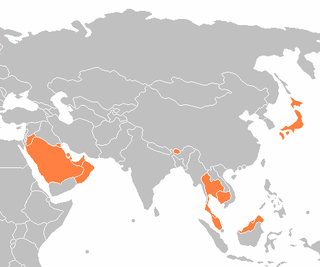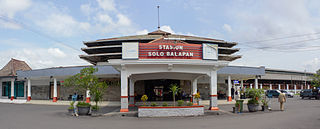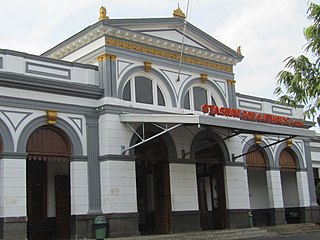Parang is a form of folk music in Venezuela and Trinidad and Tobago.
Contents
Parang may also refer to:
Parang is a form of folk music in Venezuela and Trinidad and Tobago.
Parang may also refer to:

The Special Region of Yogyakarta is a province-level special region of Indonesia in southern Java. It is a semi-enclave that is surrounded by on the landward side by Central Java Province to the west, north, and east, but has a long coastline on the Indian Ocean to the south.

Batik is a dyeing technique using wax resist. The term is also used to describe patterned textiles created with that technique. Batik is made by drawing or stamping wax on a cloth to prevent colour absorption during the dyeing process. This creates a patterned negative when the wax is removed from the dyed cloth. Artisans may create intricate coloured patterns with multiple cycles of wax application and dyeing. Patterns and motifs vary widely even within countries. Some pattern hold symbolic significance and are used only in certain occasions, while others were created to satisfy market demand and fashion trends.

Central Java is a province of Indonesia, located in the middle of the island of Java. Its administrative capital is Semarang. It is bordered by West Java in the west, the Indian Ocean and the Special Region of Yogyakarta in the south, East Java in the east, and the Java Sea in the north. It has a total area of 33,750.37 km2, with a population of 36,516,035 at the 2020 Census making it the third-most populous province in both Java and Indonesia after West Java and East Java. The official population estimate in mid-2023 was 37,608,336 The province also includes a number of offshore islands, including the island of Nusakambangan in the south, and the Karimun Jawa Islands in the Java Sea.

Surakarta, known colloquially as Solo, is a major city in Central Java, Indonesia. The 46.72 km2 (18.04 sq mi) city adjoins Karanganyar Regency and Boyolali Regency to the north, Karanganyar Regency and Sukoharjo Regency to the east and west, and Sukoharjo Regency to the south. On the eastern side of Solo lies Solo River. Its metropolitan area, consisting of Surakarta City and the surrounding six regencies, was home to 6,837,753 inhabitants according to the official estimates for mid 2023, 526,870 of whom reside in the city proper.

Parangtritis Beach is a tourist beach on the southern coast of Java, in the Bantul Regency within the Special Region of Yogyakarta, Indonesia. There is a road to the area which is about 30 km south of the city of Yogyakarta. This beach is located south of Parangkusumo Beach, which is also a mainstay of tourism in Bantul Regency. This beach is often visited by local and foreign tourists.

Yogyakarta is the capital city of the Special Region of Yogyakarta in Indonesia, in the south-central part of the island of Java. As the only Indonesian royal city still ruled by a monarchy, Yogyakarta is regarded as an important centre for classical Javanese fine arts and culture such as ballet, batik textiles, drama, literature, music, poetry, silversmithing, visual arts, and wayang puppetry. Renowned as a centre of Indonesian education, Yogyakarta is home to a large student population and dozens of schools and universities, including Gadjah Mada University, the country's largest institute of higher education and one of its most prestigious.

Nyi Roro Kidul is a supernatural being in Indonesian folklore. She is the Queen of the Southern Sea in Sundanese and Javanese mythology.

Bantul is a town and district, and the capital of Bantul Regency, Special Region of Yogyakarta, Indonesia. The district (kapanewon) covers an area of 21.95 km2 (8.47 sq mi) and had a population of 64,360 at the 2020 Census. It is a bustling town about 10 km (6.2 mi) to the south of Yogyakarta, easily reached by regular minibuses from the main Yogyakarta bus station. Bantul has numerous firms and agencies which supply services to the surrounding area. A main road runs down from Yogyakarta through Bantul to the busy beach area of Parangtritis visited by many tourists from Yogyakarta each weekend.

A pendhapa or pandhapa is a fundamental element of Javanese architecture unique in the southern central part of Java; a large pavilion-like structure built on columns. Either square or rectangular in plan, it is open on all sides and provides shelter from the sun and rain, but allows breeze and indirect light. The word pendhapa is cognate to the Sanskrit word mandapa ("hall").
Kraton may refer to:

There are several monarchies in Asia, while some states function as absolute monarchies where the king has complete authority over the state, others are constitutional monarchies where a monarch exercises authority in accordance with a constitution and is not alone in decision making.

Taman Sari Water Castle, also known as Taman Sari, is the site of a former royal garden of the Sultanate of Yogyakarta. It is located about 2 km south within the grounds of the Kraton, Yogyakarta, Indonesia. Built in the mid-18th century, the Taman Sari had multiple functions, such as a resting area, a workshop, a meditation area, a defense area, and a hiding place.

Solo Balapan Station is a major railway station in Surakarta, Central Java, Indonesia. The name "Balapan" is taken from the name of a village which is located to the north of the station. The station is located on the railway line that connects the cities of Bandung, Jakarta, Surabaya, and Semarang. Solo Balapan Station is the largest station in Surakarta and Central Java.

The LAPAN LSU-02 is an unmanned aerial vehicle (UAV) developed by the Lembaga Penelitian dan Penerbangan Nasional (LAPAN) of Indonesia. It was developed in 2012 for both civilian and military purposes. The Indonesian military classifies it as a tactical UAV because of its ability to fly over long ranges for its size. It broke an Indonesian record for longest ranged UAV built locally.

Parang batik is one of the oldest Indonesian batik motifs. Parang comes from the Javanese word Pereng which means slope. Parang depicts a diagonal line descending from high to low. The arrangement of the S motifs intertwining unbroken symbolizes continuity. The basic shape of the letter S is taken from the ocean waves which depict a spirit that never goes out.

Tujuh rupa batik is one of the Indonesian batik motifs originating from Pekalongan, Central Java. This tujuh rupa batik motif is very thick with natural nuances. In general, tujuh rupa batik displays animal or plant motifs. The motifs are taken from various mixtures of local culture and Chinese ethnicity. Because, in the past, Pekalongan was a transit point for traders from various countries. Thus, it is this cultural acculturation that makes Pekalongan batik unique to nature, especially the jlamprang motif, the bouquetan motif, the moonlight motif, the cement motif, the pisan bali motif and the lung-lungan motif.

Solo Jebres Station, also known as Jebres Station, is a type-C large class railway station in Surakarta, Central Java, Indonesia. The station, which is located 97 metres (318 ft) above sea level, is operated by Operational Area VI Yogyakarta of Kereta Api Indonesia (KAI). It is one of the major railway stations in the city.

Palur Station (PL) is a class-III railway station located in Dagen, Jaten, Karanganyar Regency, Central Java, Indonesia. The station is located at an altitude of +93 meters and only serves KAI Commuter Yogyakarta Line. The station is about 100 meters to the northeast from Karanganyar main highway and not far from the national highway linking nearby city of Surakarta and Surabaya in East Java.
Indonesian batik patterns are coloured patterns on cloth made by the resist-dyeing technique of batik. The patterns are often associated with a particular city or region, and may have a symbolic meaning there.

Batik plays multiple roles in the culture of Indonesia. The wax resist-dyeing technique has been used for centuries in Java, and has been adopted in varying forms in other parts of the country. Java is home to several batik museums.